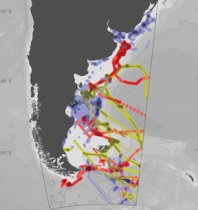|
 |
 | Northern Giant Petrel (Macronectes halli).  |
 |
The map shows the most important regions in the Patagonian Sea used by the Southern Giant Petrel, the Northern Giant Petrel and the White-chinned Petrel: the slope and the continental shelf, the Río de la Plata area, Uruguay, south of Brazil, north of the San Jorge Gulf, the slope opposite the gulf and waters to the south of the Antarctic Polar Front.
Data are on Southern Giant Petrel adults and juveniles (blue), Northern Giant Petrel adults (red) and White-chinned Petrel adults (green) belonging to colonies in Patagonia and South Georgia. All data collected by satellite instruments (PTT), between the months of January and December are included.
Dataholders: J. Croxall, J. González-Solís, R. Phillips and P. Trathan (Northern Giant Petrel); F. Quintana, J. Croxall, J. González-Solís, R. Phillips and P. Trathan (Southern Giant Petrel); J. Croxall, R. Phillips and P. Trathan (White-chinned Petrel).
| © Flavio Quintana |
 |
Principal feeding areas |
|
 |
Petrels
Approximately 23 species of petrels feed in the Patagonian Sea, but only the Southern Giant Petrel (Macronectes giganteus) breeds on the coasts of Patagonia. Seven species breed in the Malvinas Islands, one of which is the White-chinned Petrel (Procellaria aequinoctialis). The Northern Giant Petrel (Macronectes halli), a frequent visitor of the Patagonian Sea, breeds at South Georgia. Most petrels are long-lived species, requiring several years to reach breeding. Their reproductive output is low, producing at most one chick per year. These qualities make them vulnerable to any increase in adult mortality, such as that caused by fisheries. The 3 species for which we present data are under some degree of vulnerability, according to the criteria of IUCN (near threatened and vulnerable).
|

